HOW TO MAKE A WHOLE WHEAT SOURDOUGH SANDWICH BREAD THAT RISES WELL --- by Helen Dickey --- October 18, 2006
SUMMARY To make great whole wheat sandwich bread using sourdough as the yeast, put a small amount of starter into a large amount of soaked whole wheat batter to begin the process. (See below the photos for the full explanation.)
PHOTOS: (Click on any small photo below to see full size view. They tell the story of all the steps taken to make this good bread.)
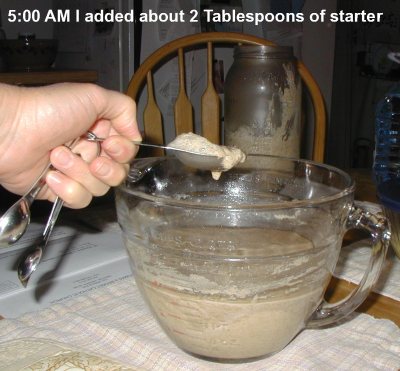
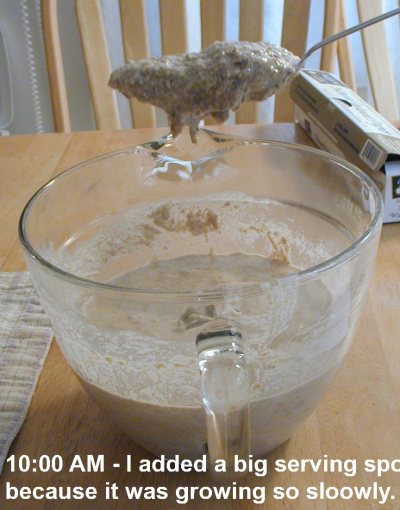
12:00 Noon
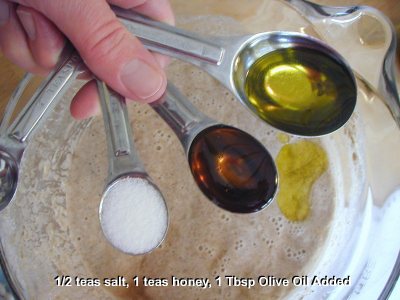
1:45 I kneed by picking up edge with butter knife, fold over, and press in several places with butter knife flat against dough.
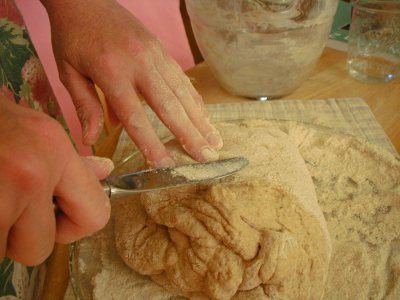
1:50
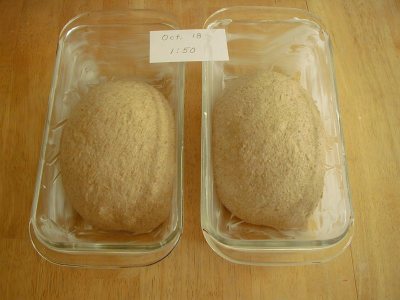
6:00
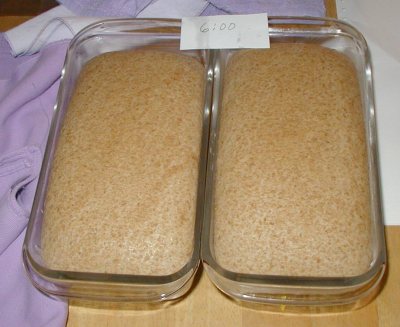
6:15
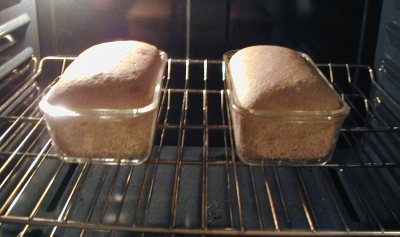
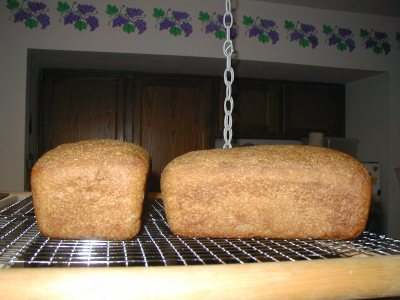
8:00
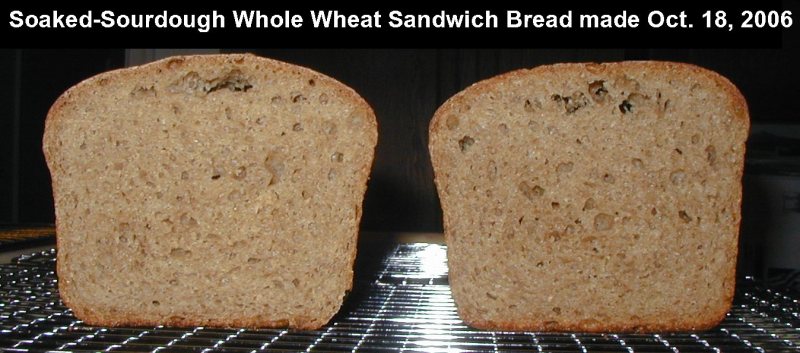
My 6-year-old made a clown out of the center then ate it up:
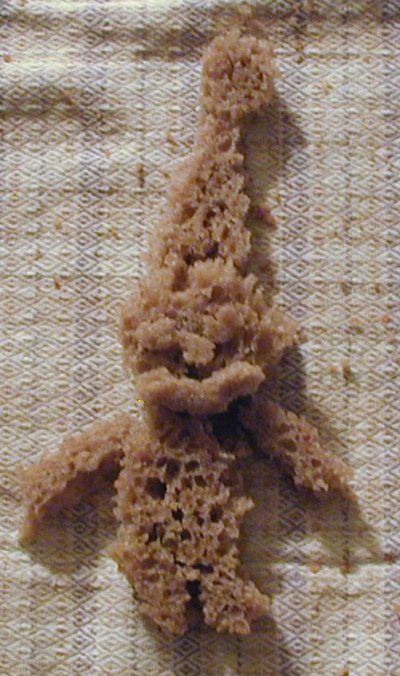
INSPIRATION: My whole wheat sourdough breads were dense. I was struggling to make a more lightweight softer bread for a few years. Finally I prayed. I asked God our Father to please show me how. I ackknowleded that He created all things, even yeasts, and recalled that He supposedly sent an angel to show Hagar or some other very early Ismaelite how to make bread, That His Son is the Bread of Life and that bread is very important. I remembered His help to me at other times and reminded Him that he knows all things. I begged Him to show me how to make a nice soft, high rising bread. When I ended the prayer, The Bible verse below popped into my mind. In it, we have a hint of how people used yeast 2000 years ago. Likely it was sourdough and apparently only a LITTLE was used to leaven a whole batch of dough. (See quote below.) So I decided to try using only a spoonful of sourdough starter in a whole batch of soaking dough. (I am a Roman Catholic.)
QUOTE: (New American Bible)
Matthew 13:31
He proposed another parable to them. "The kingdom of heaven is like a mustard seed that a person took and sowed in a field.
32
It is the smallest of all the seeds, yet when full-grown it is the largest of plants. It becomes a large bush, and the 'birds of the sky come and dwell in its branches.'"
33
He spoke to them another parable. "The kingdom of heaven is like yeast that a woman took and mixed with three measures of wheat flour until the whole batch was leavened."
BACKGROUND: First I tried to add lots of water and flour to a little starter and it did not work. It smelled bad like a bran new starter just started. I have also tried adding what amounts to flour to be soaked before the 12 hour soaking time and it worked definitely better than normal. This time, I tried adding a little starter to a SOAKED (sour) flour, water, and raw apple cider vinegar mixture that had been sitting for 12 hours. The sourdough yeast needs the acid to grow and live. The soaking in acid does something good to the flour so the yeast can eat it. Unlike a whole bunch of starter, the food for the yeast in my soaked dough was not diminished by having already been eaten up by yeast because no yeast was added to it yet. (12 hours ago I made the soaked batch without yeast--only raw apple cider vinegar.)
If you give the yeast all the food you can with an acid environment. A well-rised bread will result.
PROCEDURE:
I soaked 2 cups of water with 2 Tablespoons of Raw Apple Cider Vinegar and a little more than 2 cups of pressed down whole wheat flour for about 12 hours before adding almost 2 tablespoons of very frothy, bubblely starter (so the actual volume was less than 2 Tablespoons) from the refrigerator. I let this work into a sponge for 5 hours. The bubbles were numerous, and very tiny but not enough to cause foam or raise the volume much at all, so I then added more starter: about 1/4 of a cup. That did it! In 2 hours I had a wonderful sponge. I made the dough (by adding only whole wheat flour, olive oil, honey and salt and kneeding in more whole wheat flour) and let it sit for the first rising. Though it had not risen too much, I made 2 loaves about 1 hour and 45 minutes later. I let the loaves rise for 4 and 1/2 hours covered with a thick folded dish towel. At that time the tops were higher than the loaf pans by almost 1/2 inch, and I put the loaves into the oven at 375 degrees until they tapped hard on the top. They tapped hard after baking 1/2 hour. I then turned the oven down to 325, opened the door to let out some hot air, and baked 7 more minutes to not burn it but to make sure the wheat does not get sticky the next day (which can happen with any whole wheat bread). When cooled, we sliced and ate. The bread was very nice. It was well raised and light, springy, very soft inside and durable. Perfect for sandwiches.
CONCLUSIONS: I conclude that the yeast eats something different than what the bacteria present in a sourdough starter eats and also something different than whatever soaking uses up. I think bran is what the bacteria eat, while the white starches is what the yeast eats. Bran is also what is predigested and used when whole wheat is soaked. This experiment indicates that the white starches must be still be present after whole wheat is soaked. Because, as you see from this experiment, the yeast grew very well so it must have had more to eat than the normal the way I used to make sourdough. Normally nearly half the volume of the bater for dough was starter, whose yeast food is already eaten up to some degree. That surplus of food gave the yeast more rising power. This is a good way to make sourdough bread. It rises nicer.
NEXT TIME: I will add the larger spoon of starter to begin with. (Actually I did 2 previous undocumented experiments in which I did just that and the bread worked great. I only had to wait 3 hours in those experiments until the batch started to foam and had many bubbles at which time I made the dough.)
CREDITS: I thank God for all His wonderful inspirations to me: Lord, You hear all my prayers and I am very happy with these results. Thank you.
Click here to read how I made the starter used for this bread.









